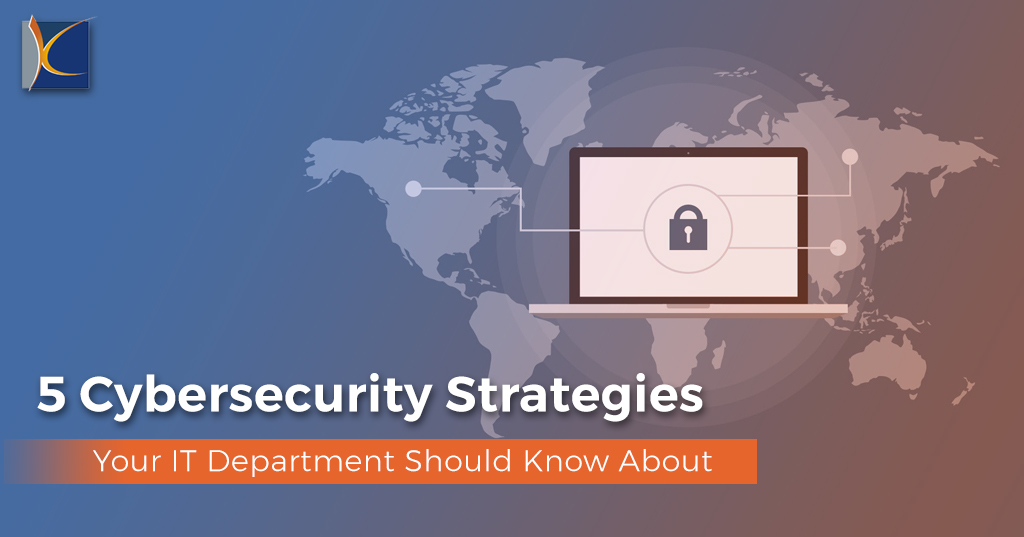
5-cybersecurity-strategies-your-it-department-should-know-about
Posted on June 6, 2018 in Uncategorized
When it comes to protecting your company’s digital assets, fewer decisions are more important than the adoption of new cybersecurity measures. Today, one out of five small businesses is affected by cyber crimes in one way or another. Even more worrying than this statistic is the fact that 60% of these businesses are shut down within six months of being attacked.
So what can businesses do to ensure they’re better equipped to withstand these attacks? Here are five cybersecurity strategies that your IT department can start to implement right now.
Deploy Firewalls and Network Segmentation
An unfiltered infrastructure can present itself as an easy target for cybercriminals. Firewalls tend to be the first and foremost line of defense against outside cyber attacks. IT teams can deploy and configure these digital walls to strike a balance between protection and usability on internal systems.
Another useful measure of protection is to segment networks into smaller subnetworks. These protective measures ensure that your company data is not stored in one central location. By splitting each computer network into several smaller ones that have the same level of cyber security, hackers have to work much harder to reach the same goal before they’re noticed and countered by your system.
Set Company User Access Controls
As your organization begins to scale, it’s essential that employee access is limited to specific role allocations. Having open access to all areas of your network makes it much harder to recognize unauthorized access from hackers. Assigning licenses and user-restrictions to your system enable you to allow or deny access to specific areas of your
system.
By having fewer people with access to sensitive areas of your operations, the less likely there will be any data leakage. By creating these role-restrictions, it will also be easy to ensure former employees don’t have access to systems once their employment has ended.
Audit Systems and Introduce Security Patches
Hackers tend to look for weaknesses in systems typically identified by outdated software and old firmware versions. IT teams should always ensure their systems maintain the latest security patches and upgrades. System patches help recognize open areas of your network that might be susceptible to attacks and enable your team to address the issues.
There are also many auto-updating systems that will automatically alert you once a new patch is available for your system. These systems can be configured to automatically download and install the latest versions of software protection, ensuring you don’t risk operating one moment without the most up-to-date protection.
Train Employees on Cyber Threat Awareness
Most companies feel like cybersecurity measures should be limited to an IT department and not involve employees in other areas of the company. However, most security breaches are caused by employees who inadvertently open malicious emails or download virus-containing files without adequately vetting the source.
By implementing a cybersecurity training schedule for all employees, organizations can ensure they significantly minimize the risk of unauthorized system access and data breaches. Cybersecurity best practices should be discussed at the outset of employment and standards should be adhered to at all times.
Create a Disaster Recovery Plan
If a system does become compromised, it’s imperative that a company is prepared to quickly bounce back and repair the damage that’s been done. Disaster recovery plans are an essential part of a company’s ability to contain cyber attacks, restore systems, and recover any lost data.
By developing a recovery plan ahead of time, you can assign appropriate personnel and procedures to get your systems back up and running efficiently and repair any damage that has been done.
Developing and executing cybersecurity measures is an integral part of scaling and sustaining your business. By staying up-to-date with the latest cyber threats and setting up appropriate defenses, you can ensure your systems stay operational and that your digital assets are always protected.

What-is-the-internet-of-things
Posted on May 8, 2018 in Uncategorized
If you are not employed in the tech industry, you have likely assumed the term “IoT” to be just another hot buzz word. While the Internet of Things (IoT) is an innovative concept in the field, you do not have to be a tech aficionado to understand, or use, the technology involved. In fact, chances are that you’re already using the IoT in your everyday life. Recent statistics show that there were 3.9 billion IoT-connected devices in use during 2016 alone.
What Is the Internet of Things?
Simply put, the Internet of Things is a system of connected physical devices that collect and share data with one another. While this may sound intimidating, it is much less complex than it may seem. Most devices equipped with a “smart” title qualify as IoT devices if they are capable of communicating with other devices. They may be in the form of a thermostat, light bulb, refrigerator, security system, watch or even a car.
The Difference Between Computers and IoT Devices
These devices are not programmed and operated like traditional computers, tablets or smartphones. This is because they do not require regular human interaction to perform tasks. Through the utilization of embedded sensors and technologies like Bluetooth, GPS, WiFi or Artificial Intelligence, these devices operate intuitively. They gather and exchange information using their own specialized device-to-device communication modules, thus creating the Internet of Things.
Examples of IoT Device Functionality
One good example of IOT device functionality is that of a smart thermostat, which uses a number of tools to learn a user’s preferences. If a homeowner typically lowers the temperature in their home before bedtime, the thermostat will predict this on its own, and no further action will be required on behalf of the homeowner. In the event that the temperature becomes too low or too high, the thermostat is capable of communicating this concern with the homeowner via a mobile app or email notification.
Another prime example is smart lighting. Several different smart bulbs can be connected to a singular home automation hub. These lighting systems often contain motion sensors or other automated systems, which trigger the hub to communicate with smart bulbs in relevant areas of the home. The hub can communicate with bulbs in the living room, for instance, and direct them to turn on upon a homeowner’s arrival. Similarly, when no motion is detected, the devices will communicate through the IoT to ensure that unnecessary lighting is powered down.
The Current Role and Future of the IoT
Currently associated with the convenience and energy-saving capabilities of home automation, the technology is a relatively new notion. Though it is purported to have been “born” between 2008 and 2009, the focus on expanding and improving it has only been mainstream in the industry for a few short years. Shockingly, it is already transforming the way that users live their daily lives, and experts predict that this is only the beginning.
Certainly there is much more to the IoT than meets the eye of everyday consumers. Experts in the IoT space work diligently on intricate setups, user-friendly platforms and advanced hardware to make the IoT possible and functional. With no shortage of applications for the technology, it is estimated that there will be a staggering 21 billion IoT-connected devices by the year 2020. Fortunately, with a general understanding of the interconnected workings of the IoT, even those with limited technological knowledge can understand the excitement and hype surrounding the future of the Internet of Things.

Blockchain-Disrupt-Industries
Bitcoin is all over the news. Seeing as this cryptocurrency surged 150% in value in a single month, a lot of people are now taking a look at blockchain, the technology that allows cryptocurrencies like Bitcoin to exist. While it’s a complicated concept, the basic framework is that blockchain eliminates the need for third-party record keeping through its ability to provide a publicly distributed, immutable ledger that ensures accuracy.
While blockchain is clearly making its mark on the financial industry, this new technology is poised to disrupt the way we do business in nearly every field. Here are five industries that will soon see the effects of blockchain:
1. Healthcare
Medical records are some of the most personal and sensitive pieces of information about us. Hospitals often lack the data infrastructure to both securely store these records and share them effectively with necessary providers. Startups and established healthcare companies are working to implement blockchain medical record keeping to ensure integrity and trust in the system.
2. Food Safety
With blockchain, transactions are permanently recorded in a ledger that everyone can access. This means near instantaneous tracking of the supply chain of anything recorded in the blockchain. In the event of an E. coli outbreak, food safety personnel can determine the source of the contamination almost immediately and work to get dangerous food off the shelf that much faster. Not only can that save money, it can potentially save lives.
3. Banking
The reason that Bitcoin has had such success lies in the fact that it has removed the intermediary once needed for financial transactions. With blockchain, banks are no longer necessary for verifying that someone has the money they claim to have. Distributed ledgers will soon come to challenge banks as the sole record keepers of the financial world, opening up the door to new financial tools altogether.
4. Real Estate
Real estate is a multi-trillion dollar industry. However, a lot of that money is tied into the paperwork involved in deeds, records, contracts and plats. While in-person interactions have traditionally handled those types of documents, the ability to put things like title transfer into blockchain will reduce costs dramatically and make fraud much more difficult.
5. Legal
Traditionally, contracts passed back and forth between parties for the purpose of making changes, where others then reviewed and made their own changes. With an immutable record, the once time-intensive process of contract creating, signing and even enforcement can be reduced dramatically, saving time and money. Intellectual property, deed management and public records all stand to see changes with blockchain technology, signaling a bout of disruptions on the horizon for the legal industry.

Blockchain
The blockchain is the technology behind Bitcoin, Ethereum, Litecoin and other cryptocurrencies. While these are the most well-known uses of the blockchain, its benefits mean it has far-reaching implications for finance and data security beyond the cryptocurrency industry.
The blockchain is a distributed database (a database which is stored on many different devices). This means that recorded transactions are verified by hundreds or even thousands of different actors (also called nodes). The number of nodes makes blockchain far more secure than a simple database stored on just one device: you can’t just change one copy to commit fraud – you have to change thousands.
How does it work?
Blockchain Tracks and Verifies Transactions Using Blocks and Keys
The distributed database holds a list of transactions, which are called blocks. These blocks stack up in a chronologically-linked chain; each one is time-stamped and references the block before it. These blocks exist in a strict order which cannot be changed.
The blocks and the transactions they hold are public, and anyone with a copy of the database can see them. It is impossible to make a change to an old block without the nodes noticing, flagging and rejecting the change.
When a transaction is made, it is verified using two keys: one private, one public. The private key is known only to the account holder and is used as a signature to confirm who the transaction has come from. The public key, which everyone has, can be used to decrypt and authenticate the transaction, but cannot be used to create a transaction; this prevents a user from creating false transactions.
What Are The Advantages and Disadvantages of Blockchain Technology?
Because of the way it works, blockchain has several key benefits:
An Unchangeable Database – The data held on a blockchain cannot be changed. Every transaction, once logged and accepted, is held on the chain and kept there forever. This makes it highly transparent and makes auditing transactions easy.
Reduced Costs – Transactions are verified by the nodes holding the blockchain, which means that traditional middlemen (such as banks) aren’t needed. Banks are investing heavily in the blockchain because if they ignore it, they might find themselves not needed.
Users Are Empowered – The blockchain allows users to have full control over their transactions and data. For example, the blockchain could enable individuals to have control over who accesses their medical records.
As with any system, there are also disadvantages:
Verification Bottlenecks – The cryptographic system used to sign and check transactions is complex, and requires a lot of computing power. This means there is a limit to how fast transactions can be processed.
More Work – When a transaction occurs it must be processed by every single node that holds a copy of the database (which could be thousands). This is a lot of extra computational work compared to a traditional database, where the transaction is processed just once.
What Can Blockchain Be Used For?
Blockchain can be used anywhere where a transparent, unhackable database would be useful, and businesses and governments are testing a wide variety of use cases. There is a high level of hype and excitement, but in this case, it might actually be justified – blockchain really does have the potential to revolutionize many industries.
For example, blockchain could be used to prevent voter fraud by being used as the platform for an unhackable vote-counting system which would both securely check voter’s identities and prevent changes from being made by a third party.
Another use case is as a means of authenticating ownership of a unique item, such as a piece of art. The art piece would be paired with a digital token, which could then be bought or sold. Even if the art piece was physically stolen, the original owner would still hold the ownership digitally. Any attempt at selling it on would fail because anyone would be able to look up the true owner.
 Kenneally Technology Services was recently requested to provide their expertise to a national cybersecurity organization and their online publication. Here is an excerpt with a link to the full article if you wish to continue reading:
Kenneally Technology Services was recently requested to provide their expertise to a national cybersecurity organization and their online publication. Here is an excerpt with a link to the full article if you wish to continue reading:
The “little guy mentality” can no longer be relied upon to protect and safeguard your systems in today’s environment.
Much attention has been paid to major data breaches that have affected large corporations, United States government agencies, not-for-profits and political organizations. This attention has resulted in the allocation of significant resources, both monetary and intellectual, to shore up business and government defenses against different types of cyber threats. In fact, an entire educational industry has emerged as high schools and universities now offer courses and majors for a new generation of cyber-warriors.
That is all well, good and necessary given cyber’s national security and financial implications, but it fails to address the core of the American economy. Tens of thousands of small-to-medium-sized businesses (SMBs) do not have an existing or adequate cybersecurity budget. Perhaps worse, these organizations often feel that due to the small size of their business they will not be the targets of a cyber-attack?
This perception is simply not correct. Last summer, the FBI reported that as of late 2013 (the latest data available), more than 7,000 U.S. companies, of all sizes, were victims of phishing scams, with losses exceeding $740 million. Symantec Corporation has observed a steady increase in attacks targeting businesses with less than 250 employees, with 43 percent of all attacks targeted at small businesses in 2015, proving that companies of all sizes are targeted…










